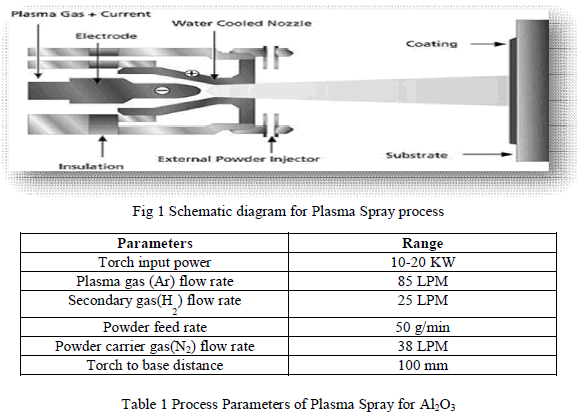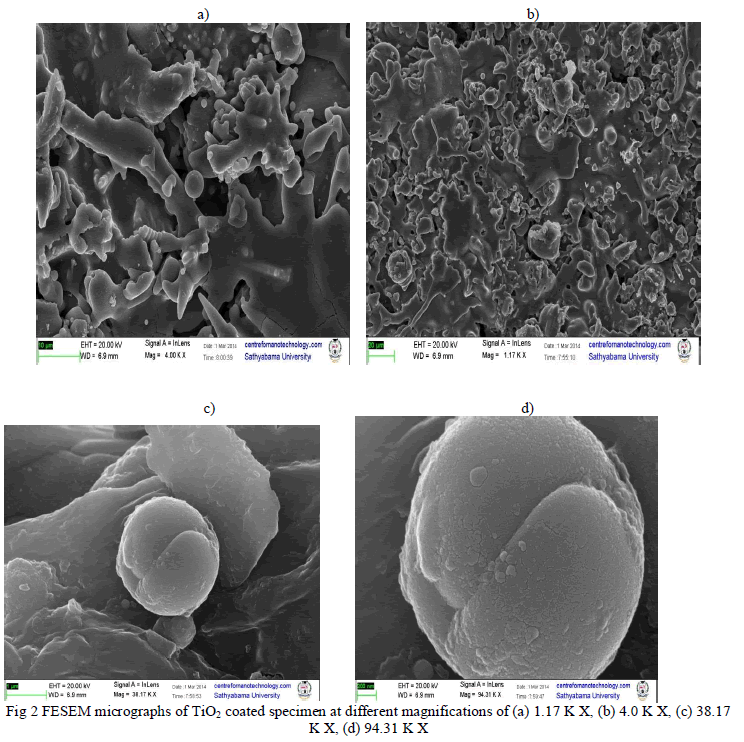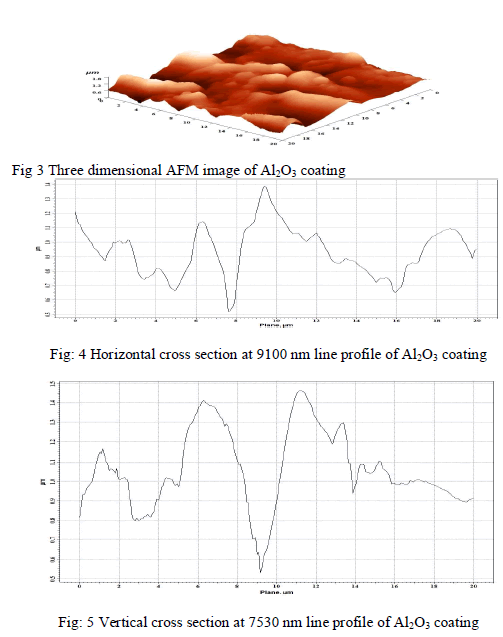ISSN ONLINE(2319-8753)PRINT(2347-6710)
ISSN ONLINE(2319-8753)PRINT(2347-6710)
I Arul raj1, S Ramachandran2
|
| Related article at Pubmed, Scholar Google |
Visit for more related articles at International Journal of Innovative Research in Science, Engineering and Technology
Surface modification is a generic term now applied to a large field of diverse technologies that can be gainfully harnessed to achieve increased reliability and enhanced performance of industrial components. The increasing utility and industrial adoption of surface engineering is a consequence of the significant recent advances in the field. Among the various coating techniques to enhance the surface properties of Al2O3 coated mild steel we have adopted the thermal coating technique of Plasma spray process. The Thermal spraying is the coating deposition technology in which solid feedstock in form of powder, wire, or rods is introduced to a hot gas, flame, or plasma jet to form liquid droplets which are accelerated toward a substrate. In this paper we have discussed the surface morphology of Al2O3 coated over mild steel using various surface characterization techniques such as Scanning Electron Microscope and Atomic Force microscope.
Keywords |
| Atomic force microscope, Plasma sprays process, Scanning electron microscope, Surface modification, mild steel. |
INTRODUCTION |
| Plasma spraying is a material processing technique which uses the energy of an electric arc and gases to generate a plasma beam capable of melting and depositing metallic and non-metallic materials on a substrate.[1] This technique has been used to develop protective coatings of ceramics, alloys, and composites to enhance the surface properties of critical components operating in severe environment.[2] In conventional plasma spraying, an arc is created between a rod/stick type throated tungsten cathode and a nozzle type copper anode (both water cooled). Plasma generating gas is forced to pass through the annular space between the electrodes. While passing through the arc, the gas undergoes dissociation and/or ionization in the high temperature environment resulting plasma.[3] The ionization is achieved by collision of electrons of the arc with the neutral molecules of the gas. Plasma spraying has certain unique advantages over other competing surface engineering techniques. By virtue of the high temperature (10,000-15,000K) and high enthalpy available in the thermal plasma jet, any powder, which melts without decomposition or sublimation, can be coated keeping the substrate temperature as low as 50 0 C. The coating process is fast and the thickness can go from a few tens of microns to a few mm. The spraying technique does not impose any restriction on the work piece dimensions and large samples can be coated. In plasma spraying one has to deal with a lot of process parameters. |
EXPERIMENTAL WORK |
| The plasma torch used in the experiment is a non-transferred DC arc type as shown in Fig.1 Plasma torches used for plasma spray deposition operates in the non-transferred mode at high currents and gas flow rates. The arc energy is extracted by the plasma gas, which issues out of the torch nozzle with high velocity (600-800 m/s) and high temperature (typically 10,000-20,000K). |
 |
| Metallic or ceramic powder introduced in the plasma jet melts and the molten droplets strike the substrate surface with high velocity forming adherent coating. The cathode consists of a tungsten rod with a conical tip. About 2% thorium oxide is added to tungsten to improve the thermionic emission characteristics of tungsten. The Table 1 showing about the process parameters of Al2O3 for Plasma Spray process. The nozzle is made of copper and is designed in the form of a nozzle. An insulating block of nylon separates the electrodes. The plasma gas, usually argon, is injected into the interelectrode region through a side port in the insulator. The electrodes are intensely water-cooled. The nozzle has a port near its edge for feeding carrier gas and powders. When an electric arc is struck between the cathode and anode, the plasma gas extracts the energy from the arc and issues out of the nozzle as a high temperature, high velocity jet. A thermal pinch effect is produced by the combined action of the cold wall of the nozzle and the cold gas sheath around a very high temperature, conducting core of the arc column. Any powder introduced into the plasma jet melts and the molten particles, travelling at high velocity (about 100 m/s) are projected onto the substrate surface, where they solidify forming an adherent coating. |
RESULT AND DISCUSSION |
| 1. Scanning Electron Microscope :- |
| The morphological investigation of the top layer depositions were carried out with field emission scanning electron microscope (FESEM) Carl Zeiss SUPRA 55. Figure 2 shows the scanning electron micrograph of alumina coating at different magnifications. The microstructure consists of both partially and fully melted regions as depicted in Fig. 2 (a) and (b). It does not have large areas of partially melted regions and all the particles appear to be solidified from fully molten state. The micrograph consists of crystals attached to the molten powder particles shown in Fig. 2 (c) and (d). Large amount of porosity is not observed which will restrict the crack propagation and fracture initiation, though a considerable amount of cracks are observed at the boundaries. |
 |
| 2. Atomic Force Microscope :- |
| The atomic force microscopy (AFM) has been used to study the roughness and morphology of mild steel substrates coated with alumina. A three dimensional AFM scan over 20 μm X 20 μm is shown in Fig. 3 It depicts a number of peaks and valleys. The average and rms (root mean square) roughness was found to be 210.068 nm and 272.452 nm respectively. It is clear from the picture that the difference between lowest and highest points on the surface is 1.8 μm. |
 |
CONCLUSION |
| Plasma spray coatings provide specific properties onto the substrate that are very different from other deposition techniques. In order to achieve certain values of coating deposition efficiency the influencing parameters of the process have to be controlled accordingly. The number of parameters in plasma spraying is too large and the parameter-property correlations are not always known, precise identification of significant control parameters are necessary for optimization. The microstructures of the coatings are dependent on operating power level of the plasma torch, the physical characteristics such as coating porosity, phase formation in the raw material during spraying and also the torch to substrate distance. |
References |
|